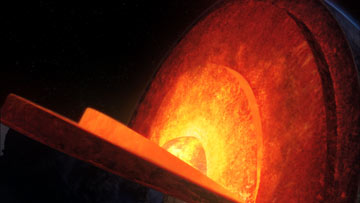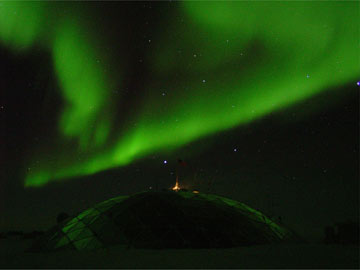|
FEATURE — Deep Earth
2007 Highlights Home page >> Deep Earth Features >> Deep Earth Highlights
Seeing Earth’s Sounds
Getting to the Core
Disappearing Slabs, the Mantle and Collaborations: A Q&A With Guy Masters
Deep Earth: Other Highlights
Seeing Earth’s Sounds
MIT’s Rob van der Hilst Explains how new technologies are helping geophysicists look deeper
 AGI/Meteor Studios |
| Thanks to new twists on established imaging techniques, increased power, large-scale seismic arrays and collaborations with applied mathematicians, scientists are beginning to learn much more from a seismic wave traveling deep within the planet than just its arrival time back at the surface. These advances help illuminate more of Earth’s inner structure than ever before. |
From crust to core, seismologists have been hunting for ever better ways to “see” Earth’s insides. In the past year, researchers have made a number of new advances in this arena, coming from many directions, such as using new twists on established techniques and listening to seismic signals from more than just earthquakes, says Rob van der Hilst, a geophysicist at MIT in Cambridge, Mass.
In March, van der Hilst and his colleagues described how they adapted an imaging technique developed two decades ago for near-surface oil and gas exploration to create high-resolution, 3-D images of deep Earth structures at the core-mantle boundary (see Geotimes, July 2007). To develop these images, they used data from thousands of earthquakes recorded at about 1,000 stations around the world, which allowed them to distinguish previously unseen details of these structures, revealing the surprising complexity of the lower mantle and enabling them to estimate the temperature near the core-mantle boundary for the first time (a toasty 3,700 degrees Celsius).
Furthermore, large-scale seismic station arrays such as Earthscope’s USArray (see Geotimes, March 2004), when combined with the “enormous increase in computing power” in recent years, are paving the way for more breakthroughs, van der Hilst says. “Many people are realizing the enormous potential that these modern seismometer arrays are providing now,” he says.
Van der Hilst is among the first wave of geophysicists using this heightened computer power to use more of an earthquake’s seismic signal to interpret Earth’s inner structure than ever before. “Typically, you have a seismogram from an earthquake, and what we used to do is use only a small fraction of the data,” he says. Geophysicists have long measured an earthquake’s travel time — the time it takes for the fastest-traveling waves generated by an earthquake, called p-waves, to travel into Earth’s interior, hit a structure such as the core-mantle boundary and bounce back to the surface, where it is recorded at a seismic station.
By compiling millions of these arrival times, you can make “nice tomographic images,” van der Hilst says. “But with all the new data from these arrays, you have so much more. What we’re trying to do is to develop new theories and ways of analysis that really make use of that richness,” using not just the arrival time of a seismic wave, but “the whole signal” as it travels through the subsurface, he says. For example, some waves may pass through several boundary layers, while others bounce back and forth between them. “All of those reverberations, that scattering, we can actually measure that,” he says. “We used to throw that away because it became so complex, but now we can begin to look at them.”
What makes that possible, he says, is not only vastly improved computer power, but a new cross-fertilization between geophysicists studying seismic waves and mathematicians who study wave propagation, waveform theory and harmonic analysis. Although the convergence of seismology, mineral physics and geodynamics created a very rich new field of study a decade ago, van der Hilst adds, “what we are beginning to see now is an enormous influx of new techniques from applied mathematics. It helps us really tackle much more complex equations, and it’s happening on many levels.”
In the next five years, however, even earthquakes may be obsolete — at least for studying the shallow crust and mantle. Aided by worldwide arrays and boosted by increased computing power, scientists are now beginning to listen and interpret seismic signals not just from powerful temblors, but from the entire “wavefield” under our feet — the rich rumble of ambient sounds resonating through Earth’s subsurface that originate from continuous background sources such as ocean waves (see Geotimes, April 2007), storms, changing weather patterns, tidal friction between Earth and the moon, and even the hum of traffic, van der Hilst says. “We can monitor [all these signals] like a stethoscope held to the surface of Earth, and listen to what’s happening down deep.”
Links:
"Boldly Going Deeper Into Earth," Geotimes, July 2007
"Magnifying a Continent," Geotimes, March 2004
"Ocean waves drive Earth's hum," Geotimes, April 2007
Getting to the Core
 Jonathan Berry / National Science Foundation |
| Auroras, such as the aurora australis (Southern Lights) pictured here glowing over the National Science Foundation Amundsen-Scott South Pole Station, are caused by the collision of streams of charged particles emitted from the sun — the solar wind — with Earth’s upper atmosphere. Earth’s protective magnetic field, which largely shields the planet from the effects of such solar storms, is thought to be generated by the convection of iron within the core. |
Compared with volcanoes, earthquakes and other powerful evidence of a dynamic Earth, or with the vast, complex variety of structures, minerals and temperatures in the mantle, Earth’s iron-dominated core may seem somewhat simple to understand. Although scientists think the core is responsible for producing the self-sustaining, convecting “geodynamo” that generates Earth’s protective magnetic field (see Geotimes, July 2007), the slowly churning liquid outer core and dense, moon-sized solid inner core have remained largely uncharted territory.
New analysis techniques, however, have begun to reveal surprising complexity in the core. Of particular interest are the boundaries that separate the mantle from the outer core (at about 2,900 kilometers deep) and the outer core from the inner core (at about 5,100 kilometers deep). Once thought to be relatively sharp, these boundaries appear to be blurring. Not only are they more gradual but also more variable in space and time, with implications for how scientists envision the structures and composition of the regions themselves. This has also affected how they think heat may be transported from core to mantle and the operation of the geodynamo.
With ever-increasing resolution from seismic tomography and the discovery of a new mineral that forms under the intense pressures and temperatures near the core, the 200-kilometer-thick layer of mantle nearest the core-mantle boundary, called D-double-prime, has been a focus of intense study. That layer, some scientists speculate, could hold explanations for everything from “superplumes” that fuel hotspots within the mantle to the ultimate fate of subducted plates (see Geotimes, July 2006). But only recently have scientists been able to recreate the extreme conditions near the core to better understand its properties.
The intense pressures and temperatures inside the core can cause its atoms and electrons to behave in odd ways, according to Viktor Struzhkin of the Carnegie Institution of Washington in Washington, D.C. Under these conditions, electrons in the core’s iron atoms are forced to move from an unpaired, rapidly spinning state to a paired, slower-spinning state, changing the iron’s density, conductivity and other properties (such as how quickly sound waves travel through the rock). By recreating the core’s conditions in the lab, Struzhkin’s team found that the transition from high-spin to low-spin states occurs over a broad range of depths, from 1,000 to 2,200 kilometers deep. That suggests a much more gradual transition than previously thought, they reported Sept. 21 in Science. Another team, led by Yingwei Fei of the Carnegie Institution, reported in the Sept. 15 Geophysical Research Letters that the iron-rich minerals also reduce in volume as a result of the altered spin state, suggesting that the lower mantle may also be denser than once thought and providing new data to better understand both what the mantle is made of and how it moves.
 AGI/Meteor Studios |
| An artist’s depiction of Earth’s core. |
Even deeper lies the boundary between inner and outer cores, where heavier elements freeze to become solid while lighter elements are sent back to the outer core, powering its convection. This boundary was once thought to be a relatively simple sphere, but recent data show that some seismic waves scatter as they reflect off that boundary and suggest more complexity. Geophysicist Barbara Romanowicz of the Berkeley Seismological Laboratory in Berkeley, Calif., and her colleagues reported Jan. 2 in Proceedings of the National Academy of Sciences that the shape of the boundary separating the inner core from the outer core may in fact have small bumps and bulges that swell and move with time, which may be connected to the growth of the inner core.
Other scientists have investigated the structure of the inner core itself, hoping to answer a long-standing mystery: Seismic waves traveling through the inner core move quickly, suggesting that its iron-nickel crystals are solid, not liquid — but they still don’t move quite as quickly as expected, prompting speculation that these solid crystals may contain tiny liquid inclusions that slow down the waves. However, Anatoly Belonoshko, a materials physicist at the Royal Institute of Technology in Stockholm, Sweden, suggested a different answer June 15 in Science: At the high pressures and temperatures within the core, the boundaries between the iron-nickel grains become “liquid-like,” moving more fluidly against each other and thus slowing down seismic shear waves traveling through them, he told Geotimes in August.
Although relatively small in size, the inner core has a big job: It stabilizes Earth’s magnetic field against pole reversals, and understanding how it evolved also provides clues to how the planet cooled during its early stages. Writing in the July Geotimes, Rob van der Hilst noted that many mysteries remain — whether the inner core has layers, what controls the orientation of its iron-nickel crystals and how it rotates relative to the rest of Earth. By delving deeper into these questions, geophysicists, seismologists, mineral physicists and other deep Earth scientists are hoping to be able to get to the core of the planet.
Links:
"Boldly Going Deeper Into Earth," Geotimes, July 2007
"Afar from close-up," Geotimes, July 2006
Disappearing Slabs, the Mantle and Collaborations:
A Q&A With Guy Masters
With new collaborations among different fields in recent years, geophysicists have developed new ways to investigate the lower mantle. Geophysicist Guy Masters of the Scripps Institution of Oceanography in La Jolla, Calif., talked with Geotimes reporter Carolyn Gramling about new advances in deep Earth research.
CG: Deep Earth research seems to have progressed rapidly in recent years; what’s driving things forward?
GM: The key thing is that mineral physics has been able to give us some numbers — it’s the glue that holds things together and allows everybody to talk to everybody else. In the last couple of years, the mineral physics community has been able to help in a couple of ways because they’re getting reliable data from real experiments.
CG: At the 2006 annual meeting of the American Geophysical Union, you talked about “disappearing slabs,” sinking plates that scientists can detect because they have different seismic velocities until they reach the lower mantle — at which point they appear to vanish. How important is it to understand whether they have been assimilated or simply aren’t there?
GM: Well, there are probably a hundred ways to hide slabs. [In that study, Lars] Stixrude was looking at the properties of a subducted slab and what happens to oceanic crust, and we just developed that as an idea of how to hide sinking slabs. But the real point is that we now have the numbers to be able to do those what-if scenarios, such as what happens to oceanic crust as it sinks. For me, the fun thing is that the numbers we’re now getting allow us to calculate connections between seismology and composition and temperature — the real things that control what’s going on in the planet. And we can ask questions like, “If I have a composition and temperature, what happens to the shear velocity, pressure, density and so on if I increase the amount of iron?”
In the past, we’ve taken seismic data travel times and made models of properties like compressional velocity and shear velocity [how fast p-waves and s-waves travel through a material] and mineral physics now allows you to tie all those things directly to composition. So for the first time we’re able to calibrate the composition of the lower mantle. People have done this for the upper mantle in the past, but it’s much more complicated [in the lower mantle].
CG: What are some of the properties you’re looking for?
GM: Density is one of the characteristics, but it’s difficult to determine seismologically. We can look at structures using long wavelengths, but the measurement is really not local. We’re not seeing anything in any detail. But you can use travel times to constrain those measurements, because they’re connected through composition. So you can actually get very detailed models of density that way.
CG: What have we learned about the makeup of the lower mantle?
GM: The lower mantle, from about 850 kilometers [below the surface] down to within a few kilometers of the core-mantle boundary, is fairly simple mineralogically until you get close to the bottom. But there’s an enormous pressure range that you can try to fit different compositions to. The solutions are non-unique and we still don’t know all the numbers that we really need to know, but we’re generally getting toward an answer.
CG: What new breakthroughs do you think are on the horizon?
GM: In the next couple of years, we really will have a thermal and chemical model of Earth. It’s going to be uncertain in places, but we’ll be able to rule out a lot of things we haven’t been able to rule out in the past. One of the things that keeps cropping up is whether the mantle is chemically stratified. This is related to the main question in the evolution of Earth that we’ve been arguing about since plate tectonics came around. [Laughs.] We’ve been doing this for 40 years now; it should be solved.

 Subscribe
Subscribe


